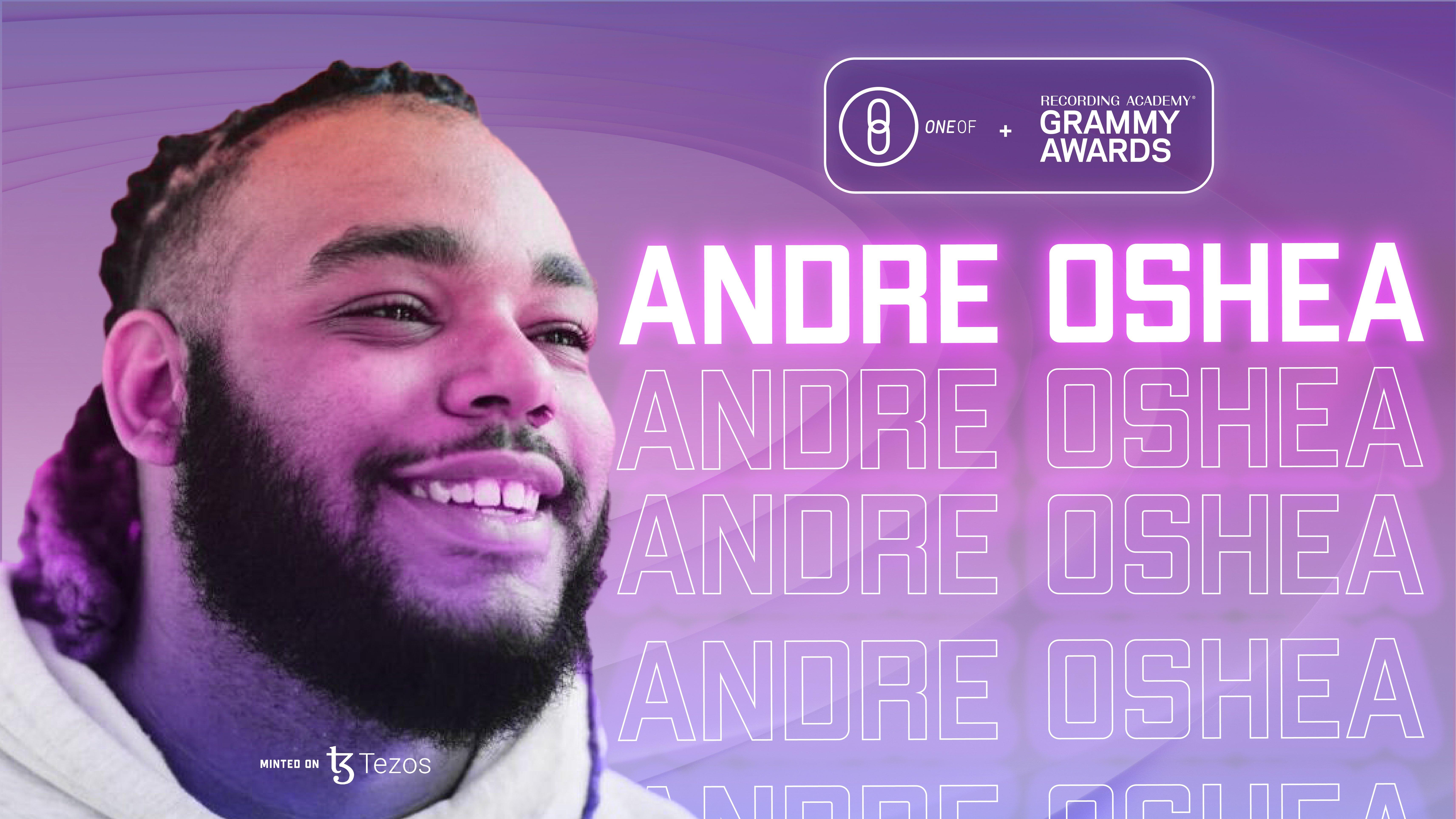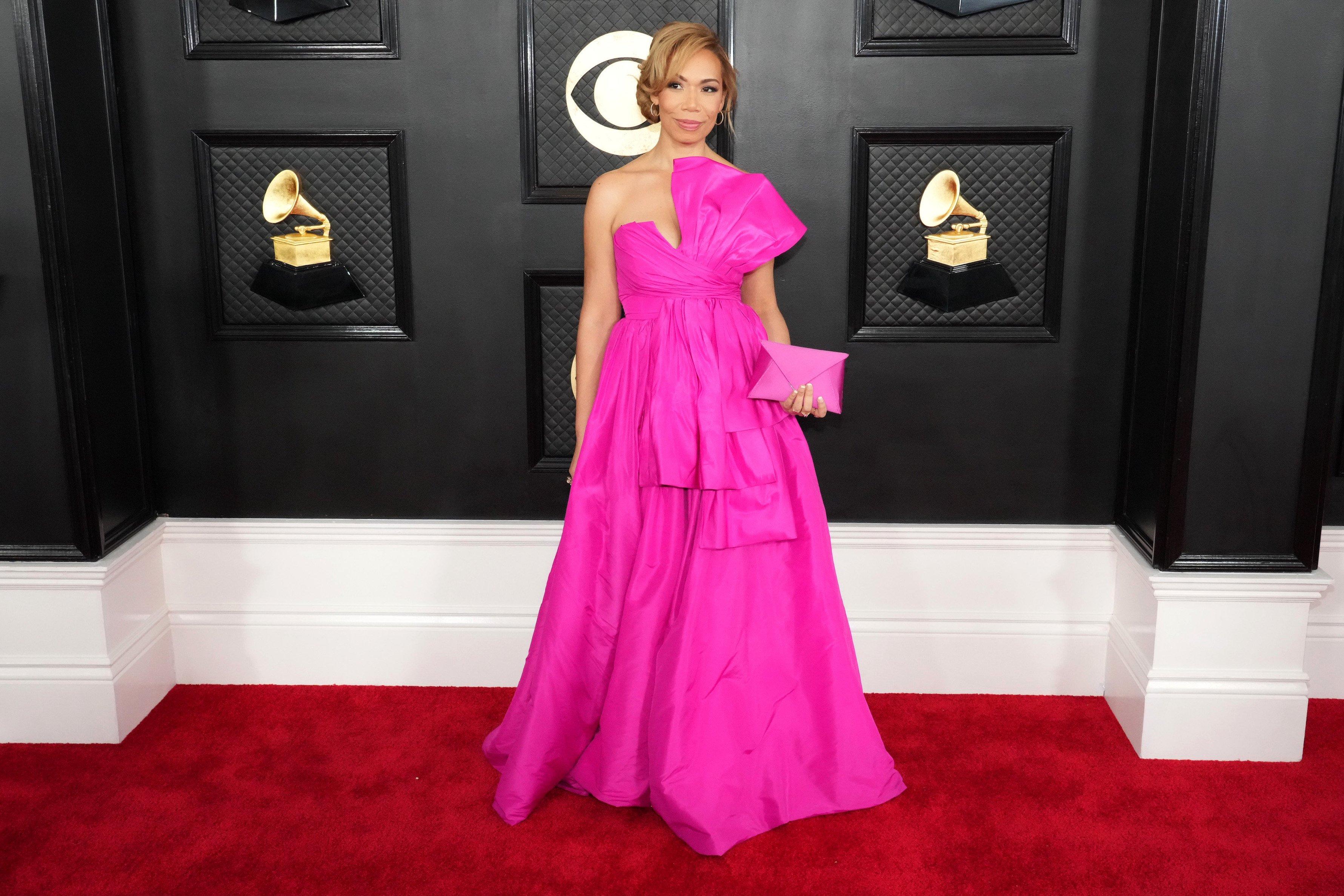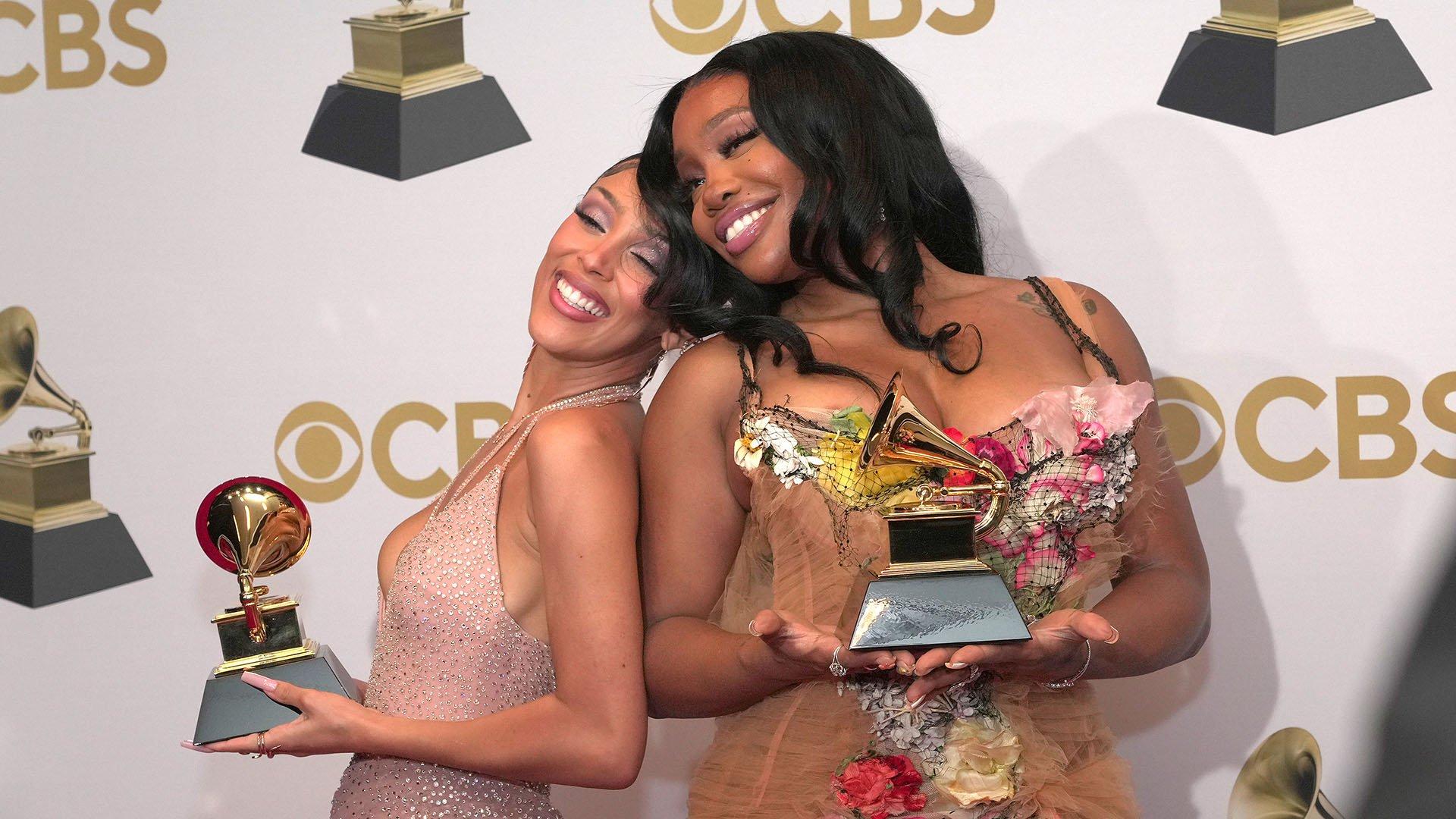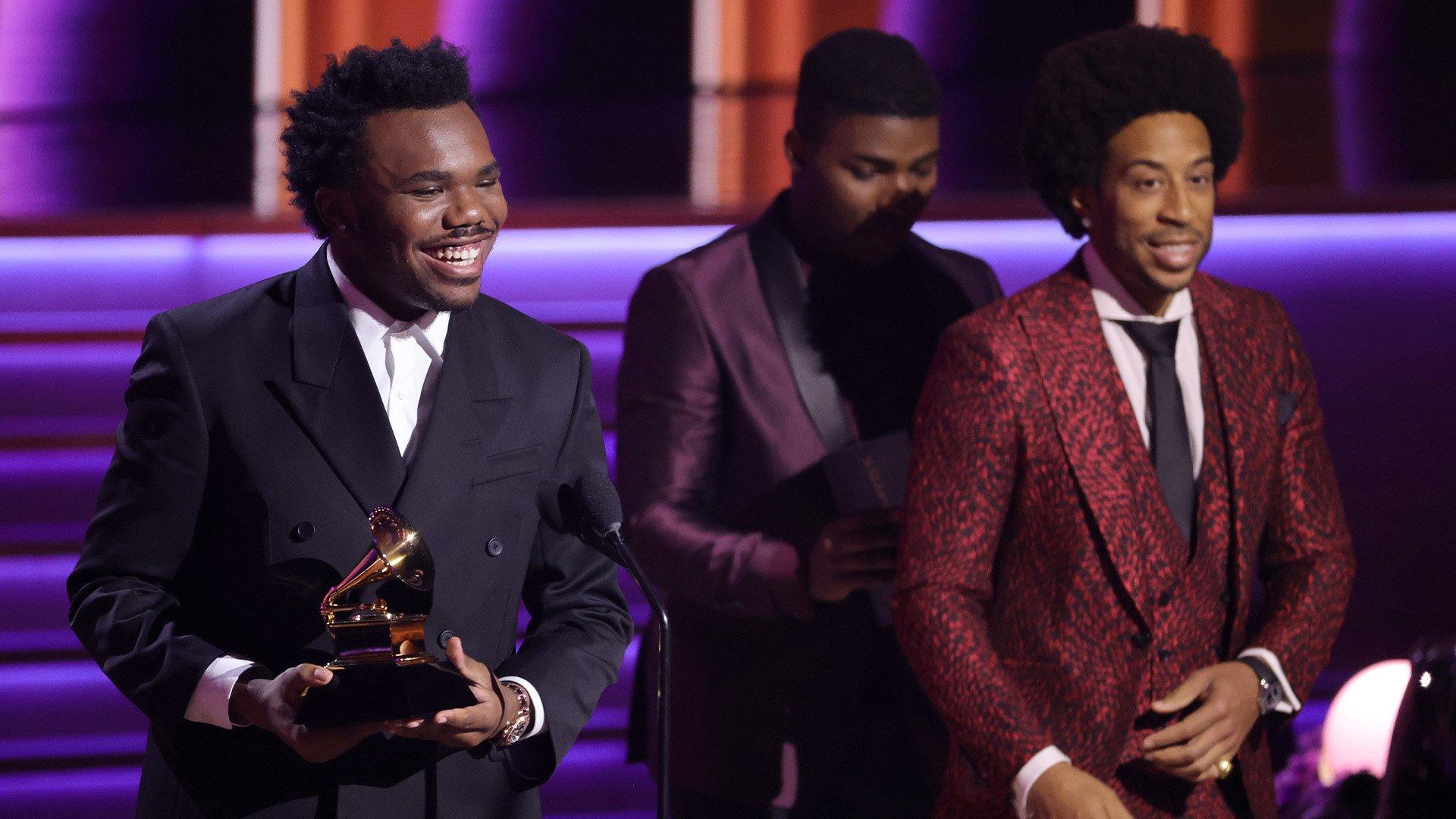Photo Courtesy of OneOf

interview
Meet Andre Oshea, The Digital Artist Making A Name For Himself In The Web3 World
Andre Oshea made his first NFT in 2021 and skyrocketed to popularity for his soothing, sensual colors and fine art techniques. Today, his musical animations are part of the GRAMMYs x OneOf NFT partnership.
3D animator Andre Oshea has had a busy year of achievements within the Web3 world, the latest iteration of the internet based on blockchain technology. He created NFT drops for Netflix and the Academy Awards, appeared in documentaries, and wrote features about Web3 — an emerging space that's conducive to Oshea's rapid rise in the digital art space.
In all his previous art output, which included 2D album cover art, logos, illustrations, and social media assets, Oshea never experienced such a quick, and instantly lucrative, response to his work as he has since selling his first official NFT in March 2021. An NFT, or non-fungible token, is how appreciators of digital art can officially own those pieces, and how digital artists can profit from creating their work.
NFTs were a natural next step for Oshea, whose clean and smooth style has the skilled touch of a classic fine artist. His use of muted colors, whose particular shades only seem to only exist in his world, have a soothing, sensual quality. His animations possess a tangibility that is both realistic and surreal — the perfect fit for a futuristic digital sphere where artists "are feeling a lot more empowered to create musically."
OneOf, a green Web3 platform built for music and sports, first connected with Oshea during Art Basel 2021, where the artist was part of a nft now x Christie's showcase. Today, Oshea is one of three artists hand-picked for the OneOf x GRAMMY Awards NFT partnership, in which he will develop a commemorative NFT that audiences can collect as an official item from the GRAMMY Awards this year.
Oshea spoke to GRAMMY.com about being a longtime fan of the GRAMMYs, his roundabout experience as a visual and musical artist, and how having two car accidents on the same day put him on the path to becoming a digital artist.
Check out Andre Oshea's 64th GRAMMY Awards NFT design.
How did you get started in the NFT space?
I saw a lot of my peers getting into it, especially 3D artists. People were telling me I should be minting [creating an NFT, putting it on the blockchain and for sale in the marketplace], months before I started. But I was confused. At that time, there wasn't the vocabulary there is now to explain what NFTs are, but I was curious. I tried minting two pieces in October 2020. I thought they would sell right away because that was all I knew [based on artist friends' experiences]. But I was so out of the loop that I didn't promote it at all.
I made my full dive into NFTs in February 2021. I had been freelancing for six years and I had just come off of a horrible experience. It was the straw that broke the camel's back. I was just over it. I posted a piece on Twitter that went viral the same day and one of my friends reached out to me and said, "We need to get you minted." I knew it took a strong community of people to really sell pieces, and I didn't know where to find that. He linked me up with a lot of other significant Black artists, and it's been a wrap since then.
It sounds like you had a learning curve as an NFT artist, which the general public is still experiencing as potential consumers.
When I minted those pieces during [my] "false start" in October 2020, it was very daunting. By the time I started minting in February 2021, Clubhouse started to hit their big boom, eventually transitioning to Twitter Spaces. Once I better understood the space, the language of how things work, I started doing a lot of onboarding sessions, which helped a lot of people and [brought] a lot of artists in, in a way that didn't exist when I was starting.
In terms of consumers, we have the right amount of people in the space right now, Obviously, you want more, because you want more collectors and more people to have the possibility of getting their work collected. But in terms of not growing too fast and putting one foot in and not tripping yourself up, where we are right now is a necessary point. People know what it is, but there isn't the widespread adoption that I think there is going to be.
The NFT community is at its elementary school level of evolution. We're in first or second grade; that's when you're starting to learn about the people around you and starting to learn who you are in relation to them. You don't want to give a first grader a ninth grade test — they're going to fail. Let them go through their maturation process.
Read: Meet Emonee LaRussa, The Digital And Visual Artist Taking The NFT World By Storm
Is there a way to speed that along?
Onboarding new people helps. As an artist, I'm looking at companies like OneOf to be doing that onboarding work to bring in the mass adoption. I don't think any one artist can do it, but working with the GRAMMYs, or Whitney Houston, piques people's interest. People might say, "I wasn't into NFTs, but I do like the idea of having an unreleased Whitney Houston song. That sounds awesome." Or, "Whoa, the GRAMMYs are doing NFTs? That sounds crazy."
How did you build your community as an NFT artist?
A lot of artists weren't on the internet and weren't leaning on social media before NFTs. I was hardcore on social media, specifically Twitter, before NFTs. That's how I got my clients. I'm very audience-oriented.
Every morning for about three years, at 8 a.m., I would post a mood board. Then at 9 a.m., I would pose a question that would prompt creative thought, specific to artists. I would make and post educational content. I would write threads about work or artwork. I would post my own artwork. When it comes to communicating and selling and talking to people online, I had already built the foundation.
How did that translate into you gaining clients?
Most of my client attraction came from being personable, active and consistent online. I started posting art online and then reaching out to people I knew saying, "This is what I'm doing." It had a trickle-down effect where somebody hits you up and says, "We really like this piece. Can we have it?" Or, "Can we use it?" Or, "Can you do this style, but with this subject matter?" That's how I started with $30 cover art and $50 logos. There are a few of my logos still floating around out there.
Now you rarely do client work and are making a living in the NFT space.
I've been an artist my entire life. When I was 11 years old, riding with my grandma through Minneapolis and we'd pass by the Walker Art Center, I used to tell her, "Grandma, I'm going to sell a painting for $3.2 million. It's going to be in the Walker." At that time, I was drawing. When I made the transition into digital art and 3D art in particular, I had no idea that this was even possible. I thought client work was how I was going to build my name and become a significant artist.
Last week, I had a 22 [Ethereum] sale; the equivalent dollar at the time was $65,000. There's a piece of my art in the world that is worth $65,000. It is blowing my mind that this is even reality for me right now. I wake up and I don't have to make art if I don't want to. There used to be a time where I couldn't go to sleep because I had to make art because there was so much client work. I would have eight active clients, and that was just to make ends meet. I feel like I've made it. I feel like I've arrived. It still hasn't hit me, but it's halfway hit me and it feels crazy.
Did you go to school for art?
When I graduated high school, my plan was to go into business because I thought I had to make money off of art through marketing and advertising. But I did the corny thing that people tell you to do: "Go to school for something you love." So I went for studio art.
I've been in art school my entire life, in elementary, middle and high school. By the time I got to college, a lot of the techniques that we were going over in our classes, I had not only been introduced to, I had almost mastered. My teacher said there was only one artist on the campus, who was a senior, who was comparable to me. I had a couple friends on campus that were musicians. We started hanging out a lot more. I stopped making visual art and solely focused on music for six years.
I moved from Delaware to Philadelphia. I produced music for artists. I had my own monthly events. I also worked at a wedding DJ company during the week and as a wedding DJ on weekends.
How did you find your way back to visual art?
During the wedding off-season, I got a job as a shuttle bus driver at the airport on the super-early shift. They were training a new shuttle bus driver and he hit my parked car with the shuttle bus, completely destroying the front. My girlfriend took the car to go to work that afternoon. There was a pile-up on the freeway and she was the front car. The front of my car had been smashed and now the back of my car was totaled. Two or three days after the car got hit, we both got fired from our jobs. Very rarely do you get messages this strong. We felt like we shouldn't be in Philly. We decided to take the message and move to Atlanta where my mom had moved a year and a half prior.
In the process, we thought why don't we learn how to make money on the internet? Why don't we grind and create jobs for ourselves? She has a creative background. I have a creative background. The goal for me always was to be able to earn from my creative outputs.
How did that lead into getting into digital art?
I picked up graphic design. I was designing album covers, Instagram Stories, promo graphics. That was how I got into digital art and then very quickly, within one or two months, I found motion design. I started playing with After Effects, and that was great because it added so much more dimension to the work.
I was also able to charge more, so I would seek out motion design clients. A month after that, I found a client who wanted 3D work. I was poking around and realized that I had a Lite version of Cinema 4D on my computer because you get it when you have After Effects. I tried making something in 3D and I have never looked back.
There were so many ideas and concepts in my mind that I hadn't been able to visualize or communicate with people without the added layer of dimension, without the interchangeability. I'm a very methodical thinker, and that lends itself to 3D. It's been a great exercise for me.
Having had the experience of being a musician, what are your thoughts about NFTs being a source of income for musicians?
I have a lot of friends who are musicians, and watching their struggles in the music industry is really challenging. Coming from the perspective of somebody who's finding a bit of career success in my medium, I feel like a lot of aspects of the music industry are broken and need to be fixed. A lot of that has to do with direct interaction with your fans, or your audience, and also, transparency about money. With NFTs and the blockchain, that really allows for musicians to be far more connected and transparent with their fans. But also, you can see the money, and it's verifiable and it's authenticated, and it doesn't change and it will never change.
I have a friend who is waiting on payment for a song she did in October. That's sort of the sneaky, backdoor dealings that happen a lot and not exclusively in the music industry, but it's highlighted there. If a company is supposed to pay you, it's their paperwork versus your paperwork. The blockchain shows, for example, "we made a million dollars off of this song; you're supposed to give me half of that, and nowhere in your records does it say that you sent me that." I think it helps the music industry be a whole lot more honest.
How the music industry works right now, people say something like, "I hope you can be on the song, but then we're going to wait to see if the song does well before we even get paid or how much we get paid." My friends who have transitioned into Web3 are feeling a lot more empowered to create musically. A music entity, even if it sells for 1 ETH, is probably more than you're going to make over the course of a couple of months. It also allows you to pay the people that you're working with a lot more, a whole lot easier, and with a whole lot more fluidity. It's transformative.
What was the inspiration for the NFT you created for OneOf x GRAMMYs?
The prompt was "the future voices of music." My experience of music has always been more electronic than acoustic. A lot of musical artists who are becoming the new leaders … did it in their bedrooms with their friends, or with the help of technology. I feel the future is very digital, very electronic, and very DIY. That's the concept and the route I took for my piece, which is an eight-second animation of floating digital instruments you would find in someone's bedroom, like a close-up shot of the keyboard, a laptop opening up, and a desk speaker with multicolored people sitting on it, representing the future voices of music: multifaceted and multidimensional.
These NFTS are the first time the general public will be able to own a piece of the GRAMMYs. What are your thoughts on that?
That's really cool. I watched the GRAMMYs a ton growing up. I was obsessed with them. I used to watch them like they were a sporting event, like it was a Super Bowl. I love things like Super Bowl T-shirts, or dated T-shirts. If I'm at a thrift store and see a 1997 White Sox shirt in my size, I'm going to get it. I can see the novelty of being involved in the GRAMMYs. If you were to collect one of these pieces, you would feel like a legitimate fan of the GRAMMYs, and of music.
We're Probably On An Irreversible Course Into The Metaverse. What Role Will Music Play In It?

Photo: Jeff Kravitz/FilmMagic
video
Where Do You Keep Your GRAMMY?: Autumn Rowe Revisits Her Unexpected Album Of The Year Win With Jon Batiste
Acclaimed songwriter Autumn Rowe reveals the inspirational location where her Album Of The Year golden gramophone resides, and details the "really funny way" she first met Jon Batiste.
Ever since Autumn Rowe won a GRAMMY in 2022, it's been her biggest motivation. That's why the musical multi-hyphenate keeps the award nestled in her writing room — to keep her creative juices flowing.
"It reminds me that anything is possible," she says in the latest episode of Where Do You Keep Your GRAMMY?
Rowe won her first-ever career GRAMMY in 2022 with an Album Of The Year award for Jon Batiste's We Are. "It was very stressful," she recalls with a laugh.
"Right before they announced Album Of The Year, the pressure started getting to me," Rowe explains. "Album Of The Year is the biggest possible award you can win. So, I'm like, 'We didn't win any of these [categories], how are we going to win the biggest award?"
The win also taught her one unforgettable, valuable lesson: "We matter. The music matters. Everything matters. We just have to create it. If there isn't space for it, we have to make space for it. Don't wait for something to open."
Rowe says she grew up "super dirt poor" and never even had the opportunity to watch the awards ceremony on television. "To be a GRAMMY winner means it is possible for everyone," she declares.
Press play on the video above to learn more about the backstory of Autumn Rowe's Album Of The Year award, and remember to check back to GRAMMY.com for more new episodes of Where Do You Keep Your GRAMMY?

Photo: Kevin Mazur/Getty Images for The Recording Academy
video
GRAMMY Rewind: Watch Doja Cat & SZA Tearfully Accept Their First GRAMMYs For "Kiss Me More"
Relive the moment the pair's hit "Kiss Me More" took home Best Pop Duo/Group Performance, which marked the first GRAMMY win of their careers.
As Doja Cat put it herself, the 2022 GRAMMYs were a "big deal" for her and SZA.
Doja Cat walked in with eight nominations, while SZA entered the ceremony with five. Three of those respective nods were for their 2021 smash "Kiss Me More," which ultimately helped the superstars win their first GRAMMYs.
In this episode of GRAMMY Rewind, revisit the night SZA and Doja Cat accepted the golden gramophone for Best Pop Duo/Group Performance — a milestone moment that Doja Cat almost missed.
"Listen. I have never taken such a fast piss in my whole life," Doja Cat quipped after beelining to the stage. "Thank you to everybody — my family, my team. I wouldn't be here without you, and I wouldn't be here without my fans."
Before passing the mic to SZA, Doja also gave a message of appreciation to the "Kill Bill" singer: "You are everything to me. You are incredible. You are the epitome of talent. You're a lyricist. You're everything."
SZA began listing her praises for her mother, God, her supporters, and, of course, Doja Cat. "I love you! Thank you, Doja. I'm glad you made it back in time!" she teased.
"I like to downplay a lot of s— but this is a big deal," Doja tearfully concluded. "Thank you, everybody."
Press play on the video above to hear Doja Cat and SZA's complete acceptance speech for Best Pop Duo/Group Performance at the 2022 GRAMMY Awards, and check back to GRAMMY.com for more new episodes of GRAMMY Rewind.
How 'SOS' Transformed SZA Into A Superstar & Solidified Her As The Vulnerability Queen

Photo: Matt Winkelmeyer/Getty Images
video
GRAMMY Rewind: Watch Baby Keem Celebrate "Family Ties" During Best Rap Performance Win In 2022
Revisit the moment budding rapper Baby Keem won his first-ever gramophone for Best Rap Performance at the 2022 GRAMMY Awards for his Kendrick Lamar collab "Family Ties."
For Baby Keem and Kendrick Lamar, The Melodic Blue was a family affair. The two cousins collaborated on three tracks from Keem's 2021 debut LP, "Range Brothers," "Vent," and "Family Ties." And in 2022, the latter helped the pair celebrate a GRAMMY victory.
In this episode of GRAMMY Rewind, turn the clock back to the night Baby Keem accepted Best Rap Performance for "Family Ties," marking the first GRAMMY win of his career.
"Wow, nothing could prepare me for this moment," Baby Keem said at the start of his speech.
He began listing praise for his "supporting system," including his family and "the women that raised me and shaped me to become the man I am."
Before heading off the stage, he acknowledged his team, who "helped shape everything we have going on behind the scenes," including Lamar. "Thank you everybody. This is a dream."
Baby Keem received four nominations in total at the 2022 GRAMMYs. He was also up for Best New Artist, Best Rap Song, and Album Of The Year as a featured artist on Kanye West's Donda.
Press play on the video above to watch Baby Keem's complete acceptance speech for Best Rap Performance at the 2022 GRAMMYs, and check back to GRAMMY.com for more new episodes of GRAMMY Rewind.
How The 2024 GRAMMYs Saw The Return Of Music Heroes & Birthed New Icons

Photo: Jeff Kravitz/FilmMagic
video
GRAMMY Rewind: Kendrick Lamar Honors Hip-Hop's Greats While Accepting Best Rap Album GRAMMY For 'To Pimp a Butterfly' In 2016
Upon winning the GRAMMY for Best Rap Album for 'To Pimp a Butterfly,' Kendrick Lamar thanked those that helped him get to the stage, and the artists that blazed the trail for him.
Updated Friday Oct. 13, 2023 to include info about Kendrick Lamar's most recent GRAMMY wins, as of the 2023 GRAMMYs.
A GRAMMY veteran these days, Kendrick Lamar has won 17 GRAMMYs and has received 47 GRAMMY nominations overall. A sizable chunk of his trophies came from the 58th annual GRAMMY Awards in 2016, when he walked away with five — including his first-ever win in the Best Rap Album category.
This installment of GRAMMY Rewind turns back the clock to 2016, revisiting Lamar's acceptance speech upon winning Best Rap Album for To Pimp A Butterfly. Though Lamar was alone on stage, he made it clear that he wouldn't be at the top of his game without the help of a broad support system.
"First off, all glory to God, that's for sure," he said, kicking off a speech that went on to thank his parents, who he described as his "those who gave me the responsibility of knowing, of accepting the good with the bad."
Looking for more GRAMMYs news? The 2024 GRAMMY nominations are here!
He also extended his love and gratitude to his fiancée, Whitney Alford, and shouted out his Top Dawg Entertainment labelmates. Lamar specifically praised Top Dawg's CEO, Anthony Tiffith, for finding and developing raw talent that might not otherwise get the chance to pursue their musical dreams.
"We'd never forget that: Taking these kids out of the projects, out of Compton, and putting them right here on this stage, to be the best that they can be," Lamar — a Compton native himself — continued, leading into an impassioned conclusion spotlighting some of the cornerstone rap albums that came before To Pimp a Butterfly.
"Hip-hop. Ice Cube. This is for hip-hop," he said. "This is for Snoop Dogg, Doggystyle. This is for Illmatic, this is for Nas. We will live forever. Believe that."
To Pimp a Butterfly singles "Alright" and "These Walls" earned Lamar three more GRAMMYs that night, the former winning Best Rap Performance and Best Rap Song and the latter taking Best Rap/Sung Collaboration (the song features Bilal, Anna Wise and Thundercat). He also won Best Music Video for the remix of Taylor Swift's "Bad Blood."
Lamar has since won Best Rap Album two more times, taking home the golden gramophone in 2018 for his blockbuster LP DAMN., and in 2023 for his bold fifth album, Mr. Morale & the Big Steppers.
Watch Lamar's full acceptance speech above, and check back at GRAMMY.com every Friday for more GRAMMY Rewind episodes.
10 Essential Facts To Know About GRAMMY-Winning Rapper J. Cole
